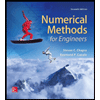
Concept explainers
A jet fighter's position on an aircraft carrier's runway was timed during landing:
| t, s | 0 | 0.52 | 1.04 | 1.75 | 2.37 | 3.25 | 3.83 |
| x, m | 153 | 185 | 208 | 249 | 261 | 271 | 273 |
where x is the distance from the end of the carrier. Estimate (a) velocity
(a)
To calculate: The velocity of the jet fighter landing on an aircraft carrier’s runaway using Numerical Integration.
Answer to Problem 44P
Solution:
The velocities at different points of time of a Jet fighter are given below,
| 0 | 0.52 | 1.04 | 1.75 | 2.37 | 3.25 | 3.83 | |
| 153 | 185 | 210 | 249 | 261 | 271 | 273 | |
| 68.26923 | 54.80769 | 50.97398 | 35.93855 | 16.05180 | 6.59273 | 0.303817 |
Explanation of Solution
Given Information:
The position of a Jet fighter on an aircraft carrier’s runway is,
| 0 | 0.52 | 1.04 | 1.75 | 2.37 | 3.25 | 3.83 | |
| 153 | 185 | 210 | 249 | 261 | 271 | 273 |
Formula Used:
Second-order Lagrange interpolating polynomial.
Here,
Calculation:
Consider the function
Apply second-order Lagrange interpolating polynomial to each set of three adjacent points for calculation of velocities at different points.
Calculate
Substitute
Substitute the value of function from above table.
Calculate
Substitute
Substitute the value of function from above table.
Calculate
Substitute
Substitute the value of function from above table.
Calculate
Substitute
Substitute the value of function from above table.
Calculate
Substitute
Substitute the value of function from above table.
Calculate
Substitute
Substitute the value of function from above table.
Calculate
Substitute
Substitute the value of function from above table.
The velocities at different points of time of a Jet fighter are given below,
| 0 | 0.52 | 1.04 | 1.75 | 2.37 | 3.25 | 3.83 | |
| 153 | 185 | 210 | 249 | 261 | 271 | 273 | |
| 68.26923 | 54.80769 | 50.97398 | 35.93855 | 16.05180 | 6.59273 | 0.303817 |
(b)
To calculate: The acceleration of the jet fighter landing on an aircraft carrier’s runaway using Numerical Integration.
Answer to Problem 44P
Solution:
The complete table of acceleration for different values of velocity is given below,
| 0 | 153 | 68.26923 | -35.14510 |
| 0.52 | 185 | 54.80769 | -16.63004 |
| 1.04 | 210 | 50.97398 | -13.20841 |
| 1.75 | 249 | 35.93855 | -26.99478 |
| 2.37 | 261 | 16.05180 | -23.26046 |
| 3.25 | 271 | 6.59273 | -10.80560 |
| 3.83 | 273 | 0.303817 | -10.88029 |
Explanation of Solution
Given Information:
The velocities at different points of time of a Jet fighter are given below as calculated in Part (a).
| 0 | 0.52 | 1.04 | 1.75 | 2.37 | 3.25 | 3.83 | |
| 153 | 185 | 210 | 249 | 261 | 271 | 273 | |
| 68.26923 | 54.80769 | 50.97398 | 35.93855 | 16.05180 | 6.59273 | 0.303817 |
Formula Used:
Second-order Lagrange interpolating polynomial.
Here,
Calculation:
Consider the function
Calculate the acceleration
Calculate
Substitute
Substitute the value of function from above table.
Calculate
Substitute
Substitute the value of function from above table.
Calculate
Substitute
Substitute the value of function from above table.
Calculate
Substitute
Substitute the value of function from above table.
Calculate
Substitute
Substitute the value of function from above table.
Calculate
Substitute
Substitute the value of function from above table.
Calculate
Substitute
Substitute the value of function from above table.
Want to see more full solutions like this?
Chapter 24 Solutions
Numerical Methods for Engineers
 Advanced Engineering MathematicsAdvanced MathISBN:9780470458365Author:Erwin KreyszigPublisher:Wiley, John & Sons, Incorporated
Advanced Engineering MathematicsAdvanced MathISBN:9780470458365Author:Erwin KreyszigPublisher:Wiley, John & Sons, Incorporated Numerical Methods for EngineersAdvanced MathISBN:9780073397924Author:Steven C. Chapra Dr., Raymond P. CanalePublisher:McGraw-Hill Education
Numerical Methods for EngineersAdvanced MathISBN:9780073397924Author:Steven C. Chapra Dr., Raymond P. CanalePublisher:McGraw-Hill Education Introductory Mathematics for Engineering Applicat...Advanced MathISBN:9781118141809Author:Nathan KlingbeilPublisher:WILEY
Introductory Mathematics for Engineering Applicat...Advanced MathISBN:9781118141809Author:Nathan KlingbeilPublisher:WILEY Mathematics For Machine TechnologyAdvanced MathISBN:9781337798310Author:Peterson, John.Publisher:Cengage Learning,
Mathematics For Machine TechnologyAdvanced MathISBN:9781337798310Author:Peterson, John.Publisher:Cengage Learning,






